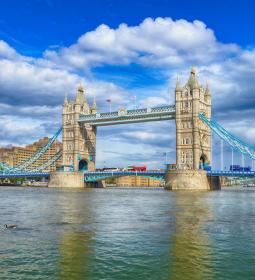Geologists claim that once the Mediterranean Sea was a lake: both in the East and in the West there was no way out of it. However, the movement of tectonic plates and other processes changed the face of the continent: first, the sea became smaller in the East (as a result, the independent Black and Caspian Seas stood out), and then, for unknown reasons, a strait between Europe and Africa arose. By the way, it is small - 13 kilometers, and in clear weather the inhabitants of the Spanish and Moroccan coasts can see the opposite coast.
In total, almost 90 million people live in the region, and the idea to connect both states and continents with a steel or at least a concrete bridge strip is in the air. But for some reason, no one is in a hurry to implement it physically.
Why is that? Let's find out.
In itself, the idea to build a bridge with a length of 13 kilometers is trivial and does not seem to modern engineers something completely impossible. For example, the bridge between the Kuban and the Crimean Peninsula, opened not so long ago with such pathos, almost reaches 20 kilometers. And in China, there are bridges with a length of 40-50 (or even more) keme. The longest existing bridge over the water (we do not take overpasses over desert or swampy areas, of which there are also many in China ) is between Hong Kong and Macau, former colonies of Great Britain and Portugal, respectively, a little more than two decades ago returned to Beijing. Its length is 56 kilometers.
So why isn't there a bridge in Europe? Are the engineers worse off or is there no money? Yes and no.
The idea to connect the African and European coasts was dreamed of in the middle of the XIX century. Once, for this, it was even proposed to build a dam and block the Strait of Gibraltar entirely. Fortunately, there were no resources for this adventure.
On the other hand, the bridge project was in the air, and in 1979 the governments of Morocco and the Spanish Bourbons who returned to the throne came to the unity that the idea was so good. In 1988, the Moroccan king even expressed the hope that the bridge would be completed during his lifetime. However, these hopes proved futile. The problem is that the current level of technological development in Europe is not enough to make such a design, laying in it the requirements for safety and reliability.
Together we will create a service architecture from scratch.

The most serious difficulty lies in the fact that the strait is too deep: in a place where the distance between the rocks is minimal, the seabed sinks to a kilometer depth (recall that the strait in Kerch is no deeper than 30-40 meters, and the Eiffel Tower is less than four times). You can, of course, slightly deviate towards the West, where the bottom rises to the surface.
But even in this case, with an increased width of the strait to 25 kilometers, you will have to put supports of three hundred meters depth. Another difficulty is the multidirectional currents, which seriously complicates the work of engineers and hydraulic engineers to calculate the resistance of the structure.
But if you can cope with this, then the supports under water, and even three hundred meters high, are still an insurmountable difficulty. The longest existing supports are for the Padma Bridge under construction in the Republic of Bangladesh; we are talking about columns with a height of 122 meters on thirty-meter piles.
Structurally, the bridge is considered incredibly complex, and the project is ambitious on the verge of impracticability. So what can we say about the prospects and reality of building a bridge in the open ocean on supports of almost a kilometer or even, what the hell is not joking, three hundred meters long? That's impossible. Not in this decade, and most likely not even in this century.
We'll go the other way!
Where it is impossible to build a bridge over water, you can build a road under it. The most famous tunnel of comparable characteristics is the European tunnel, pierced under the English Channel and connecting France and Great Britain. Its length exceeds 51 kilometers.

Maybe that's the solution?
Unfortunately, tunnels are less reliable and cost more. And taking into account the fact that the Azores-Gibraltar fault runs between Africa and Europe along the ocean floor in this very place, construction at the current level of technology development is again impossible. Or rather how? You can build it. What if the plates move?
Okay tunnel, but all the coastal infrastructure tens of miles around will also be destroyed. An illustration of this thesis can serve as an incident in 1755, when an earthquake near the coast completely destroyed the Portuguese capital, Lisbon.
Another reason is the difficulties with an incredibly hard rock. Once engineers in Spain had already received an order for the design of the tunnel, but were forced to abandon the order, as the base of the seabed was too hard and intractable.
However, the refusal to build in the 30s does not mean that after that the work was not carried out in principle. Moreover, they even made a trace, calculating the ideal route for laying the tunnel. So, if the project is implemented, the total length of the tunnel will be 39 kilometers, of which 28 and a half will be laid under water. The slope of the tunnel will be three degrees, and the maximum depth of laying will slightly not reach five hundred meters.
Optimists believe that the construction will take ten years, fifteen million euros and thousands of workers. What is surprising: the project had potential investors! After leaving the EU and throwing off the burden of supporting pants in Eastern Europe, the British faced food shortages and increased prices for its supply. Therefore, the construction of a bridge in Morocco, where they grow everything necessary for the British, from tomatoes and oranges to berries, will be useful to them. Accordingly, the increased economic activity of regional players will have a positive impact on the Gibraltar Peninsula, which is in the possession of Great Britain, and the Spaniards and the Portuguese will fall a little.














